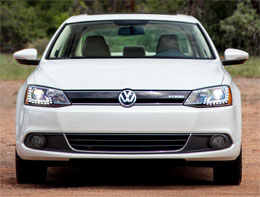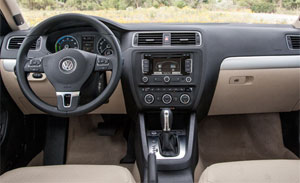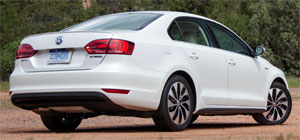2013 Volkswagen Jetta Hybrid
Up until now, Volkswagen’s preferred method of maximizing mileage has with TDI turbocharged diesel engines. But despite wider availability, and ever cleaner exhausts, high diesel fuel prices have stalled their appeal to Americans. What to do? Well, you could turbocharge a small gasoline engine as many automakers are doing to EcoBoost their mileage, and of course there’s always hybrid powertrains. Well, how about combining the two… in the Jetta!
 You won’t see turbo in the name, but the 2013 Volkswagen Jetta Hybrid does indeed get down the road with a combination of internal combustion, forced air induction, and electric power. And it all works fairly seamlessly, though you can feel some shudder when the gas engine engages and disengages. It’s not disturbing; just more of a reminder of what exactly is going on.
You won’t see turbo in the name, but the 2013 Volkswagen Jetta Hybrid does indeed get down the road with a combination of internal combustion, forced air induction, and electric power. And it all works fairly seamlessly, though you can feel some shudder when the gas engine engages and disengages. It’s not disturbing; just more of a reminder of what exactly is going on.
And, what’s going on is 1.4-liters worth of all-aluminum, direct injected, turbo-charged I4 combined with a 20kW electric motor to output 170-horsepower and 184 lb-ft. of torque. This combo produces Government Fuel Economy Ratings of 42-City, 48-Highway, and 45-Combined. That compares to 34 Combined for the TDI. Still, our lead-footed drivers netted nowhere near the hybrid ratings, averaging just 36.7 miles-per-gallon of Premium. That’s about 5% less than our last Jetta TDI. To be fair, we tested the hybrid in freezing temperatures which required additional gas engine running time so mileage should improve in warmer weather.
No disappointment with the very good Energy Impact Score of 7.3-barrels of oil burned annually with yearly CO2 emissions of 3.3-tons.
And we love almost everything about the Jetta Hybrid, as it is all so well done. The under-hood is pristine and purposeful with little hint of hybrid hardware, save for the orange high voltage cables. Trunk finish is exceptional for a non-luxury compact car; you do lose some cargo space due to the battery, 11.3 cubic-ft. versus 15.5 in a standard Jetta; but you still get fold down rear seatbacks for long item storage.
 You can follow along with hybrid goings-on with a unique instrument cluster that forgoes the tach for a power gauge with readings for eco, charge, and boost. If you opt for navigation, you can also keep up with the specific hybrid screens and power flow diagrams. And there was good power flowing at the track, as the Hybrid feels every bit as spirited off the line as the standard Jetta and a bit better than the TDI. 0-60 in 8.0-seconds flat. And, that’s still with 40 MPG potential.
You can follow along with hybrid goings-on with a unique instrument cluster that forgoes the tach for a power gauge with readings for eco, charge, and boost. If you opt for navigation, you can also keep up with the specific hybrid screens and power flow diagrams. And there was good power flowing at the track, as the Hybrid feels every bit as spirited off the line as the standard Jetta and a bit better than the TDI. 0-60 in 8.0-seconds flat. And, that’s still with 40 MPG potential.
The Hybrid comes exclusively with Volkswagen’s 7–speed DSG automatic gearbox and we have no complaints about its very smooth operation or the commanding feel of its shifts as the car worked its way to the end of the ¼-mile in 16.2-seconds at 87 miles-per-hour. The Jetta’s mix of turbo and hybrid boost proved to be a great pairing; you get the e-boost off the line and once you get rolling, the turbo gets spooled up and gives you another. It’s surprising to us that it’s taken this long for such a powertrain to arrive.
When it comes to cone carving, the Jetta is by far at the top of the compact hybrid heap. The independent rear suspension comes straight from the sportier Jetta GLI and makes the Hybrid feel light yet solid, and very sport sedan like. It’s the hybrid you would expect Volkswagen to make. While on the street, the brakes may have a grabby feel because of the regenerative braking, especially at slow speeds, we were more than impressed at the track where we averaged just 119-feet to stop from 60.
The Jetta Hybrid will drive on battery power alone, but due to the small 1.1-kWh size, only for about a mile and only up to 44 miles-per-hour if E-mode is selected. But it is easily the most entertaining full hybrid out there, not so much that you forget it’s a hybrid, but pretty darn close.
 You’d be hard pressed to tell by looking at it either, as the Jetta Hybrid is not super flashy looking, and bears little indication of its new eco-friendly credentials. But the details are nice, with the blue-highlighted VW logo and hybrid badging integrated smoothly into the Jetta’s classy and understated design. It also adds a new front fascia with redesigned air inlets, unique 17-inch wheels, and a rear spoiler.
You’d be hard pressed to tell by looking at it either, as the Jetta Hybrid is not super flashy looking, and bears little indication of its new eco-friendly credentials. But the details are nice, with the blue-highlighted VW logo and hybrid badging integrated smoothly into the Jetta’s classy and understated design. It also adds a new front fascia with redesigned air inlets, unique 17-inch wheels, and a rear spoiler.
When it comes to pricing, the Jetta Hybrid starts at $25,790. If you’ve been contemplating a hybrid, but non-committal due to not wanting to drive a boring car, well here’s the car you’ve been waiting for. And since you asked, yes Volkswagen will continue to offer the Jetta TDI which is far less well equipped but still cheaper by 2-grand.
Which one is right for you? Well we can’t answer that, but the 2013 Volkswagen Jetta Hybrid is a beautifully done hybrid wrapped in a very tidy package that we would enjoy living with every day. That’s why we picked it as our MotorWeek Drivers’ Choice Best Eco Friendly. And if you were to pick one for yourself, we think it would be just as friendly to you as it is to the environment.
Specifications
- Engine: 1.4-liters
- Horsepower: 170
- Torque: 184 lb-ft.
- 0-60 mph: 8.0 seconds
- 1/4 mile: 16.2 seconds @ 87 mph
- EPA: 42 mpg city/ 48 mpg highway
- Energy Impact: 7.3 barrels of oil/yr
- CO2 Emissions: 3.3 tons/yr
2024 Polestar 2
More Range And More Power For The Polestar 2
Volvo is well on their way to making the transition to an all-electric brand, but their sister-brand Polestar is already there. Now, we’ve spent lots of time in their all-wheel drive, five-door Polestar 2, having tested it in 2021, and a year later when a two-wheel drive version arrived. But, EV updates are coming quickly. So, let us be your guide for all that’s new with the Polestar 2.
While we are driving more EVs than ever, we’ve also been spending a lot of time recently circling back to ones we’ve previously tested. As in this new era of electrified vehicles, significant updates are arriving quickly, with R&D investments increasing and retrofitting them easier than ever. This is often done through software updates that can even be accomplished over the air. For 2024, the Polestar 2 has indeed gotten some software updates, but some physical ones as well.
Clearly aimed directly at Tesla’s Model 3 when it arrived; the Polestar 2’s build quality was vastly better, but range definitely came up short. So, addressing that was priority No. 1; and for ’24 the Polestar can travel up to 20% farther than before while consuming 9% less energy, and when it comes time to charge it back up, it can do that 34% faster too.
Range in the Single Motor version increases from a max of 270 to 320 miles thanks to a larger 82-kWh battery pack, and that solitary motor now powers the rear wheels, not the front wheels. It’s also bigger, coming in at 220 kW compared to the previous 170 kW front-wheel drive version, going from 231 to 299 horsepower.
Dual Motors keep the same 78-kWh battery, but still sees a boost from 260 to 276 miles and takes advantage of the larger rear motor for a new combined 310-kW output with 421 horsepower. Our test car has the added Performance Pack, which uses an additional 35 kW to deliver 455 horsepower and 546 lb-ft of torque, though max range drops to just 247 miles.
The new battery in rear-drive 2s will also charge faster, now accepting up to 205 kW for an 80% charge in 20 minutes; max for dual-motors stays at 155 kW, which puts an 80% charge at 34 minutes. Using 32 kWh of electricity per 100 miles, the Dual Motor earns a good efficiency rating.
The [Polestar] 2 has always been one of the most enjoyable EVs to drive, even more so now with that additional power coming from the rear motor.
Unfortunately, extremely cold temperatures kept us from seeing that increased range, as we were only on pace for about 194 miles in our test.
The 2 has always been one of the most enjoyable EVs to drive, even more so now with that additional power coming from the rear motor. And especially when equipped with the Performance Pack as it not only includes more power, but adds 20-inch forged wheels, upgraded brakes, and adjustable Ohlins Dual Flow Valve performance dampers. It greatly improves handling prowess without affecting ride quality, and is easily worth the $5,500 charge if you at all enjoy driving.
Even on a 20-degree track day there was plenty of grip through our handling course. No understeer or oversteer, and lots of feedback through the wheel. There was a nice, strong launch off the line that properly planted us firmly in the seat, and rocketed us to 60 in 4.5 seconds. Power delivery stayed pretty intense up until about 80 mph when there was a definite tapering off. Still, it was a 13.4-second quarter-mile at 102 mph; smooth, quiet, and stable the whole way.
When this car debuted, its Google-based infotainment setup was a novelty, but since then, more and more manufacturers are just “Googling it” so it doesn’t seem out of place at all. The wireless phone charger is easy to access, and there’s a great Harmon/Kardon sound system and panoramic sunroof to enhance the in-cabin experience. Exteriors have also been enhanced with a smooth grille insert and new wheel choices.
Hatchback practicality means 14.3 cu-ft of easy to access cargo space with split-folding seatbacks for longer items and expanding the space to 38.7 cu-ft. Plus, there’s even a sizeable storage bin up front under the hood.
Single Motor Polestar 2 pricing now starts at $51,300, with Dual Motors starting at $56,700; topping out at $64,400.
For a car manufacturer that hasn’t even been around for a decade yet, Polestar has kept itself busy, totally transforming their latest model in just a few years, making the 2024 Polestar 2 even more appealing. They are certainly off to a good start, and with a host of Polestars just over the horizon, including some all-important utility vehicles, this star will be shining even brighter.
Specifications
As Tested
- Motor Setup: Dual Motor
- Horsepower: 455
- 0-60 mph: 4.5 seconds
- EPA Range: 247 miles
- Efficiency : 32 kWh / 100 miles
- Battery Size: 78-kWh
- Torque: 546 lb-ft
- 1/4 Mile: 13.4 seconds at 102 mph
- MW Test Loop: ~ 194 miles
- Peak Charging Rate: 155 kW











































